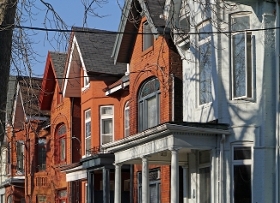A comparison of two condos
This report compares two new condominium buildings in Toronto: The first built to meet National Model Energy Code Standards and the second built to exceed these standards by 25%. The two buildings are almost identical, except that the second building uses half the natural gas of the first thanks to a tigher building envelope (doors, windows, roof, walls) and better mechanical systems, including heat recovery ventilators. Click here to read the full study.
15 Kensington (condominium): Case study of a 30-year-old condominium in Brampton that cut its natural gas use by 28%, water use by 29% and electricity use for cooling by 50%. The building is now saving $65,000 per year on utility costs and will have recovered its upfront costs in under five years. Click here to read the case study.
24 Manor Road (rental apartment).: Case study of a 128-unit rental apartment building constructed in 1970. Building envelope upgrades included low-e argon filled windows and insulated balcony doors and a new roof. An 84 collector solar water heating system was also added to the roof. The building is saving more than $33,300 per year in utility costs and the payback, when increased rental income is included, is three years. Click here to read the case study.
2 Aberfoyle Cres. (condominium). Despite being a relatively new building, upgrades to this building’s mechanical systems have cut operating costs by more than $35,000 per year. Aberfoyle demonstrates that even relatively new buildings can take action to save energy and money. In this case, the retrofit strategy including re-deploying relatively new boilers to provide back-up to a new more efficient condensing boiler. Click here to read the case study.
849 Broadview Ave. (rental apartment) - As an 80-year-old building badly in need of modernization, there was no shortage of opportunities for improvement in this building’s energy use. But the new owners were careful to stage their upgrades in a way that ensured both positive cash flow and synergies between measures. As a result, natural gas use has been reduced by 40%, water usage has dropped by 50% and electricity required for common area lighting has been reduced by 86%, all while providing tenants with more comfortable suites. Click here to read the case study.
Appleby Woods This mid-rise condominium is a great example of how good design can reduce both buiilding and operating costs. Despite a number of advanced features, including a geo-exchange heating and cooling system, this new building actually cost 25% less to construct than similar buildings and costs about 60% less to operate. High levels of insulation, a low window-to-wall ratio, and sensor controlled fans and lighting all help make this building an energy miser. Click here for the full case study.
Senator David A. Croll Apartments
The Senator David A. Croll Apartments at 341 Bloor St. in Toronto is a 44 year old 19 storey high rise owned and operated by Toronto Community Housing (TCH). In 2008, TCH decided to replace the building’s aging diesel emergency power generators with a combined heat and power system. This case study looks at the challenges and results of this decision.








